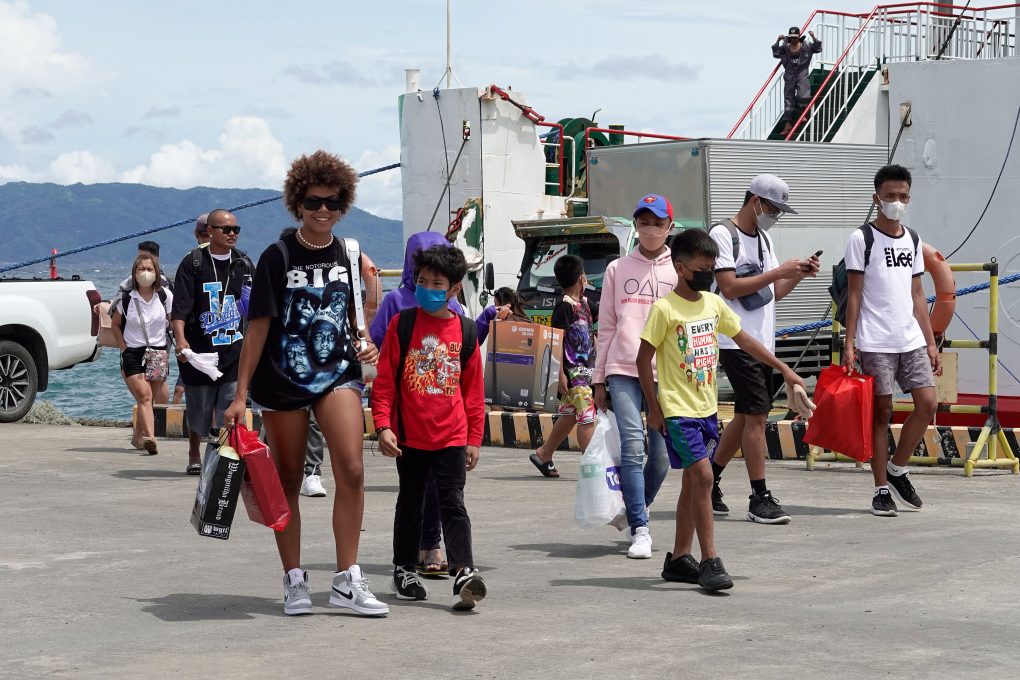I woke up at around 7:00 to ate Donna laughing. She was looking out the window down the street at kuya Jhonnie sitting at the breakfast kanto. “He’s been there for the past hour,” she laughed. I crawled over to the window and shared in her laughter.
Ate Donna, Kuya Lemmar, and I left the hotel around 8:00. We indulged in a delicious breakfast at the kanto where kuya Johnnie sat waiting. After breakfast, we walked down the heavily trafficked street to the LRT.
After living in Denmark for the past three years, observing the traffic in Manila was pure chaos. Jeepneys, cars, motorbikes, tricycles, and busses shared three lanes creating an angry melody of horns and road rage.
On the LRT
As I swayed with the steady rhythmic movement of the LRT, I pondered the countless stories I had heard, the many photos I had seen, and the documentaries and movies I had watched about Smokey Mountain in Tondo. As a child, this place completely fascinated me, now, I was actually going there. “Izana,” kuya Jhonnie’s voice snapped me out of my thoughts, “This is our stop.” I stood up, melding into the mash of people entering and exiting the LRT simultaneously. Kuya Jhonnie put his hand on my shoulder and steered me towards the doors so I wouldn’t drown in the madness.
We walked through a loud and bustling sidewalk market on the street, directly below the LRT platform. I saw a box of colorful baby chickens, ducklings, and pheasants for sale in crates. “Designer” brands from China stood on display, and air guns, flowers, knives, fruit, and street food stands filled the sidewalks. I wanted to spend more time there but ate Donna ushered me towards a waiting jeepney.
To Tondo
“Para po,” ate Donna called to the jeepney driver. He slowed down just enough to be able to jump out of the back without losing his footing. People stopped and stared when they saw us walking. Ate Donna looked at me and smiled as if she knew something I didn’t. Downtrodden permanent housing buildings towered around us. Swaying clothes and abandoned toys hung out of the windows, and a faint stench of garbage came and went with the wind.
We walked to the Tondo Community Initiative Center entrance, where Ate Nancy, Kuya Joey, Kuya Jeff, and Ate Maricel greeted us. After some introductions and signing some papers, we took an exposure trip for the books!
Green Smokey Mountain
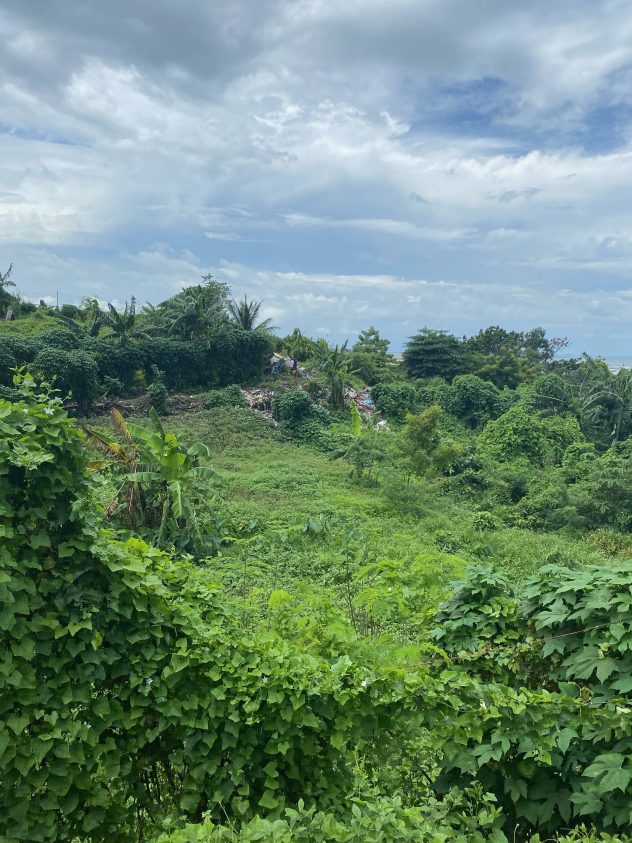 We walked out the gates of TCI and took a left. In front of us was what looked like a small mountain. I turned to ate Nancy and asked, “Ate, is that Smokey Mountain?” she smiled at me and nodded. I stared at it. “This isn’t the Smokey mountain I heard about,” I said, perplexed. I was expecting a giant garbage heap. This was, well, a green mountain.
We walked out the gates of TCI and took a left. In front of us was what looked like a small mountain. I turned to ate Nancy and asked, “Ate, is that Smokey Mountain?” she smiled at me and nodded. I stared at it. “This isn’t the Smokey mountain I heard about,” I said, perplexed. I was expecting a giant garbage heap. This was, well, a green mountain.
Ate Nancy noticed my confusion and laughed, “It’s different from what you expected, isn’t it?” I turned to her and nodded. She explained that since the government had stopped using Smokey Mountain as a garbage dump, nature took its course, and plants started to grow on top of the garbage. Walking along the side of the mountain, it quickly became apparent that there were decades of trash underneath the thin layer of dirt. The houses around the bottom of the mountain were in critical danger of landslides. What will happen during heavy rainfall? What about erosion? I could see that some erosion had already taken place. I saw pieces of garbage poking out like tree roots on a cliff.
Crossing the highway
We meandered between the community living at the mountain’s base and where industrial trucks drove at dangerous speeds on one of the biggest highways in the Philippines. Surprisingly, there was no fence, sidewalk, or anything separating these houses’ front doors from the dangers of the highway.
Finally, we reached a point on the highway before a bridge where we could safely cross the road. We stood on our side of the highway and waited for a break in the traffic. When at last there was one, Kuya Jhonnie grabbed me by the arm, and we dashed across the road. Again, this seemed absolutely bizarre to me after having lived in Denmark for three years.
At the bottom of the bridge, in a hole in a wall…
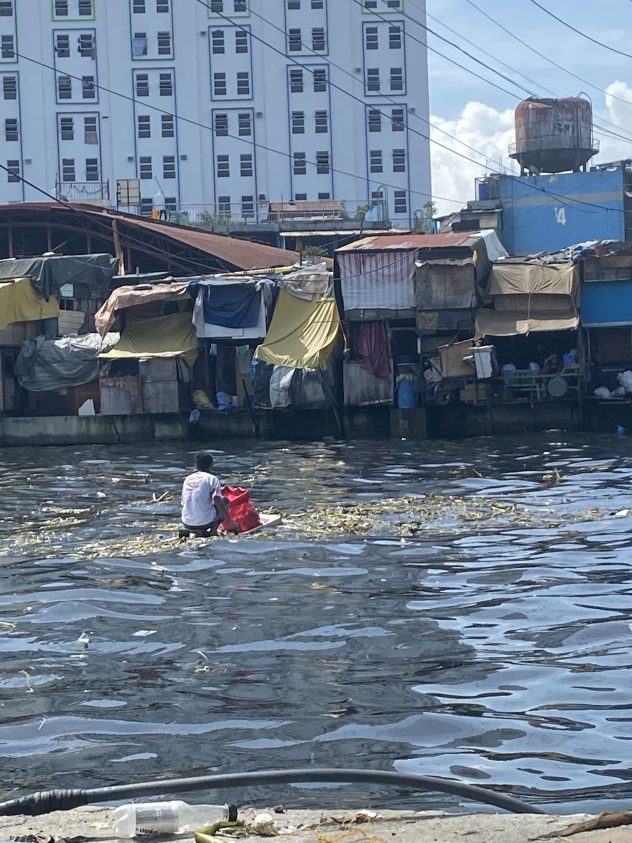 Safely on the other side, we were face to face with the LaBotas river. It flowed black and a strong stench of wet garbage emitted from it. I spotted a man on a piece of driftwood floating down the river. A red sack sat next to him. He had a tsinelas (slippers) slipped up on each arm. “Are those to keep his arms safe, help him paddle, or both?” I thought to myself. I asked ate Nancy what he was doing, and she told me he was looking for scrap metal to sell. I stood and watched him a little longer before following the group down a small road leading to the bottom of the bridge; trucks raced past.
Safely on the other side, we were face to face with the LaBotas river. It flowed black and a strong stench of wet garbage emitted from it. I spotted a man on a piece of driftwood floating down the river. A red sack sat next to him. He had a tsinelas (slippers) slipped up on each arm. “Are those to keep his arms safe, help him paddle, or both?” I thought to myself. I asked ate Nancy what he was doing, and she told me he was looking for scrap metal to sell. I stood and watched him a little longer before following the group down a small road leading to the bottom of the bridge; trucks raced past.
Ate Nancy stopped at a hole in a wall and spoke cheerfully to a woman standing next to it before she disappeared inside. Consequently, we followed. Stepping into the hole felt like we had entered a different universe. It transformed into a dark, damp passageway where two normal-sized people couldn’t walk side by side or even stand upright. On both sides of this passageway were barracks with people living there. Babies were crying, dogs were barking, people were watching television, and there was even a sari-sari store! At the end of the passage and to the left, there was another hole with a makeshift ladder going down onto a platform made of skinny planks of driftwood. Looking down through the hole, I saw water-damaged planks resulting from the many times the tide rose. The spaces between the planks were unsettlingly wide; the river flowed less than a foot below them. My anxiety grew, and my head filled with a bunch of “what ifs.” I could only think of the planks breaking underneath my feet.
Levitating Cubicles
At this point, I was the second to last person to walk down the ladder before kuya Jhonnie, who gave me a reassuring nod. Standing on the last rung, I saw that I had just entered a family’s home. It was situated directly under the bridge, yet it floated a few feet above the water! Fascination overtook my anxiety. The architecture was an absolute illusion! On the right side of me, there was a concrete wall. It was the base of the bridge above us. Pictures and other homely necessities hung here, and objects and clothes filled every crack and crevice. On my left, there seemed to be, levitating cubical rooms. There was one for everyone in the family. Each room had two floors—the first for when the water level was average and the second for when it rose.
Concrete nails
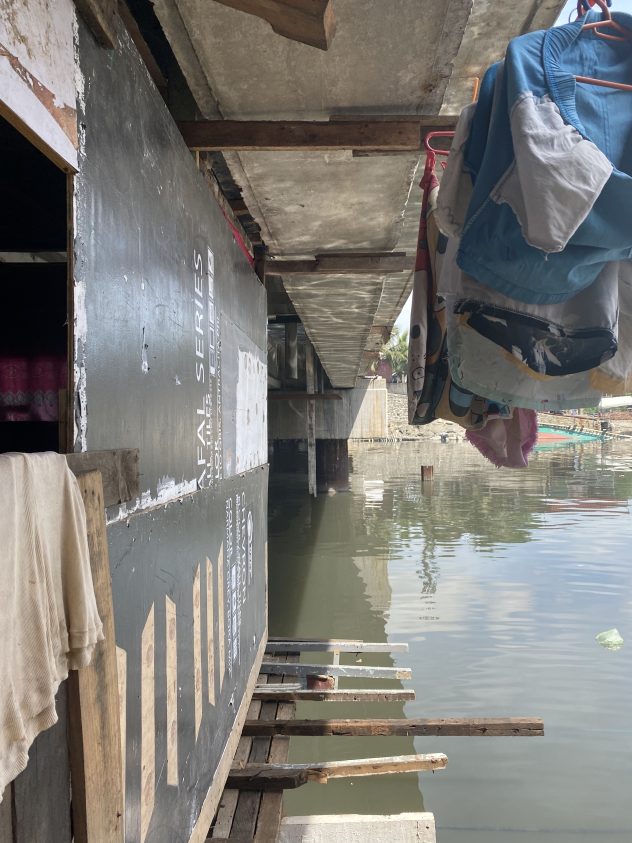 Around 5 meters away from the ladder we descended from, and at the very opposite end, floor planks rested firmly on the solid ground of the riverbank. When I stepped down from the ladder, I carefully walked over to where ate Nancy was engaged in discussion with one of the women who lived there. As if she could read my mind, ate Nancy asked the woman to explain how these rooms seemed to float mid-air above the water. “Concrete nails,” said the woman. I tilted my head puzzled, “Concrete nails?” I repeated. “Yes, po,” she nodded, “Come let me show you.”
Around 5 meters away from the ladder we descended from, and at the very opposite end, floor planks rested firmly on the solid ground of the riverbank. When I stepped down from the ladder, I carefully walked over to where ate Nancy was engaged in discussion with one of the women who lived there. As if she could read my mind, ate Nancy asked the woman to explain how these rooms seemed to float mid-air above the water. “Concrete nails,” said the woman. I tilted my head puzzled, “Concrete nails?” I repeated. “Yes, po,” she nodded, “Come let me show you.”
She ushered me to an open space where the skeleton of another cubicle hung down from the ceiling, “See, ate, look.” I carefully inspected the structure. They had hammered wooden sticks and planks into the roof with nothing other but nails! Seeing this, my anxiety once again overtook me. The laws of physics failed to explain how any of this was possible. I smiled at the woman and expressed how puzzledly impressed I was. She proudly smiled and brought me back to the place we had started. I thanked the woman for letting us into her home and carefully made my way across the thin water-damaged panels to solid ground.
A funny incident
The next day at around 4:00 in the morning, while it was still very dark out, ate Donna’s phone rang, causing me to stir from my sleep, “This is Donna,” she answered. She was already awake, sitting in the chair across from the bed, combing her hair. I put my pillow over my head to drown out the conversation and, as much as possible, squeeze in a few more minutes of sleep.
About a minute later, from under the pillow, I heard ate Donna’s muffled laughter, “What is it, ate?” I groggily inquired as I pushed the pillow away from my head, “Ate,” she said while catching her breath, “The social worker from Onesimo Center just called and asked me what time we would be there.” I blinked a couple of times. “Okay..? What’s funny about that?” Ate Donna started laughing again, “Ate, they’ve been there waiting since 2:45 this morning!” As groggy as I was, I started laughing as well, “Wow, naman ate, they must be excited!” I let out a soft chuckle as my eyes began to feel heavy again. Within seconds, Donna’s voice snapped me awake again, “Hoy, wake up na and get ready. I don’t want to keep them waiting any longer.”
Picking up the new kids
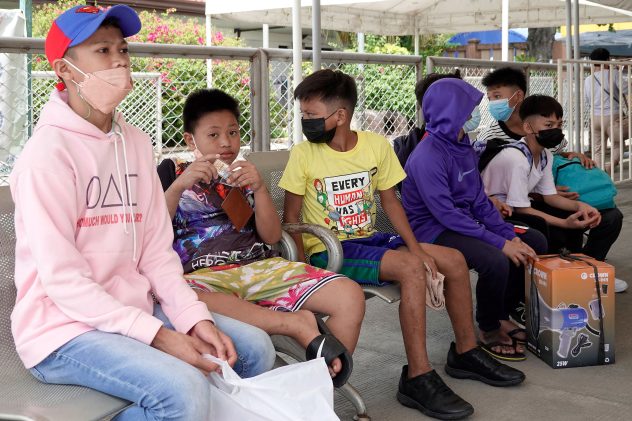 The four of us checked out of the hotel at around 5 am and loaded into the waiting van. By 5:10, we were driving, filled with excitement, to SDC to pick up the new batch of Stairway boys.
The four of us checked out of the hotel at around 5 am and loaded into the waiting van. By 5:10, we were driving, filled with excitement, to SDC to pick up the new batch of Stairway boys.
We walked through the gates of SDC and saw seven small boys and their social workers sitting on plastic chairs anxiously awaiting our arrival. Ate Donna went into the center to fill out some forms. While waiting, I noticed one of the boys staring at my shoes and saw that he was also wearing Nike, “I like your shoes,” I said to him in Tagalog. He looked at me, baffled, not expecting me to speak Tagalog. “Where did you get them?” I curiously asked. His glistening eyes lit up, and he smiled and said he got them as a gift. Ate Donna joined us again and asked the boys cheerfully if they were ready to go. Some nodded cautiously, but most stared at her with wide unknowing eyes. Kuya Jhonnie led the way out to the waiting van. The boys said their goodbyes to their social workers; a few started crying and held on to their social workers’ hands a little longer before they reassured them and ushered them into the van.
Jollibee
The sky turned brighter, and the traffic sounds had increased. The van was packed with seven kids in the back seats, Kuya Lemmar, ate Donna, and I in the middle row, and kuya Jhonnie and the driver in the front. Subsequently, turning around in my seat, I looked at the boys, and seven pairs of eyes stared back, “So,” I said in Tagalog, “Where do you guys want to eat? MacDonalds or Jollibee?” None of them responded. Instead, they all looked at each other, thinking about who would answer me. “Well?” I pressed on cheerfully, “Aren’t you hungry?” a few of them nodded, but no one spoke. A few seconds passed, and I was starting to feel a little awkward until the smallest boy, who sat directly behind me, answered softly, “Ate, I would like to eat Jollibee.” I smiled at him before looking at the others, “Are the rest of you okay with Jollibee?” All of them nodded, and I even heard a couple of “Opo’s”
After a quick stop at Jollibee, we were on the road to Batangas. We arrived at the terminal at 7:50 sharp. We did not want to miss the 8:00 boat. Shortly after making it past security and baggage check, we sat in the terminal for about 5 minutes before it was finally time to board.
It’s beautiful
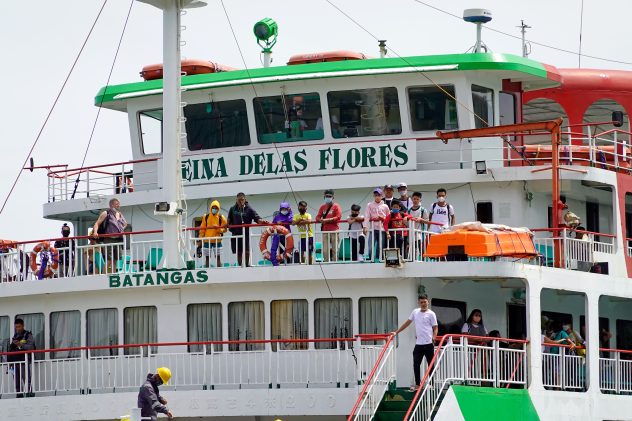 Obviously, the boat set sail at 8:20 despite the promise of leaving at 8 o’clock. As we neared the island, Kuya Jhonnie and Kuya Lemmar brought the boys to the front of the ship, where they could see Mindoro slowly approaching. After 30 minutes, I joined the boys at the front. One of them sat by himself, looking out at Mindoro. He was sitting and singing something that I couldn’t quite make out due to the wind. I walked up and leaned on the railing next to him. Straightaway, he stopped singing when he saw me and skeptically looked at me. “Do you like to sing?” I asked him. He looked at me for a couple of seconds before deciding if I was trustworthy, “Yeah, I sing a lot,” he said. “Ate, where are you from?” he asked. I smiled and explained. I was born in the Philippines. My father is Danish, and my mother is American. “I knew you were American!” he exclaimed, “You don’t look Filipino.” I laughed, “Well, I’m not.”
Obviously, the boat set sail at 8:20 despite the promise of leaving at 8 o’clock. As we neared the island, Kuya Jhonnie and Kuya Lemmar brought the boys to the front of the ship, where they could see Mindoro slowly approaching. After 30 minutes, I joined the boys at the front. One of them sat by himself, looking out at Mindoro. He was sitting and singing something that I couldn’t quite make out due to the wind. I walked up and leaned on the railing next to him. Straightaway, he stopped singing when he saw me and skeptically looked at me. “Do you like to sing?” I asked him. He looked at me for a couple of seconds before deciding if I was trustworthy, “Yeah, I sing a lot,” he said. “Ate, where are you from?” he asked. I smiled and explained. I was born in the Philippines. My father is Danish, and my mother is American. “I knew you were American!” he exclaimed, “You don’t look Filipino.” I laughed, “Well, I’m not.”
“Ate, What’s Denmark?”
“It’s a country in Europe.”
“Is it like the Philippines?”
“Oh no. It’s cold in Denmark almost always, and the people aren’t as nice as the people here.
“Why is it cold?”
“Because it’s up north, close to the North Pole.”
“Why aren’t the people nice?”
I smiled, “Because it’s always cold.”
He started laughing for a little bit before going quiet. “Ate, is the place we’re going nice?” I looked at him and smiled knowingly, “It’s beautiful.”
